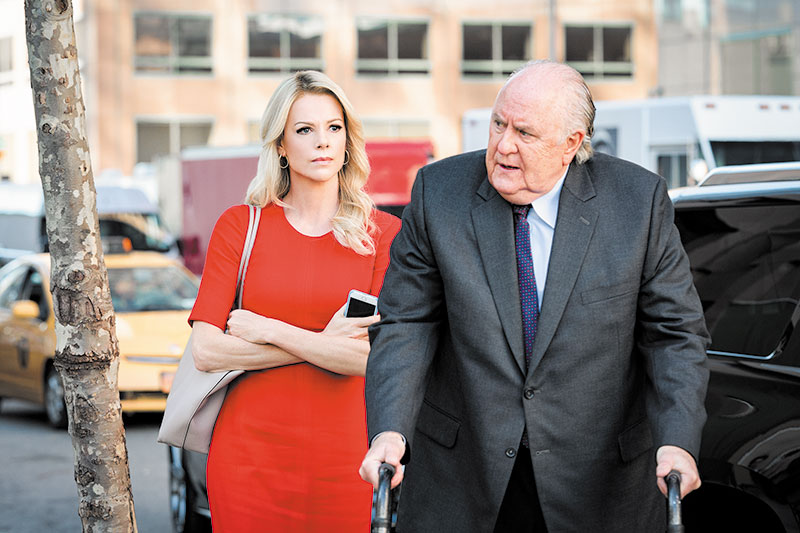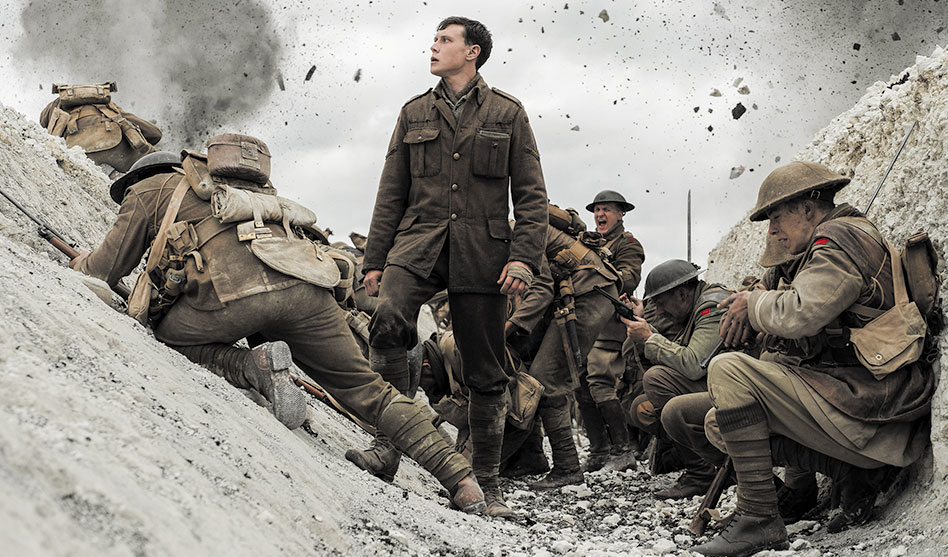‘1917’
Hollywood battles it out for holiday dominance on a variety of fronts — Europe, outer space and the halls of corporate America — during a busy but satisfying cinema season
ARNOLD WAYNE JONES | Executive Editor
jones@dallasvoice.com
Between now and the end of the year, at least half a dozen major new contenders want to occupy your free time in theaters… and that doesn’t even count the many previously-released films hoping to hold your interest. So which ones deserve your attention? Here’s our rundown.
1917
In the United States, we refer to those who fought in World War II as the Greatest Generation, but in Europe, we have that wrong by about 25 years. There, it was the Great War — retrospectively renamed World War I — that demonstrated British resolve, heroism, engagement. In the first modern war (fighter planes had just been invented), England stepped up and became an integral part of Europe, a condition that would last until Brexit. The war was nonetheless devastating. Although the Triple Entente proved victorious, 60 million Europeans were mobilized, including around 8 million Brits, about 10 percent of whom lost their lives. It was as culture-altering to the U.K. as the American Civil War was to the U.S.
You may have gotten some sense for the fierceness of conflict in a movie like War Horse, but for a viscerally existential rumination on the intimate graveness of the war, there’s never been anything like 1917.
The plot is a straight-forward ticking-clock scenario: Two lance corporals, Blake (Dean-Charles Chapman) and Schofield (George McKay), are napping during a rare moment of downtime in a trench in France when a general sends for Blake, who buttonholes Schofield to join him. They are informed that a battalion barely eight miles away is readying an attack, thinking they have the upper hand against the Germans, but it’s a trap. There’s no way to let them know except by a two-man expedition: Get the new order to the field commander by the morning, or 1,800 will be slaughtered. (It’s basically the same plot as A New Hope.)
Blake is especially keen on completing the mission: His brother is in the doomed battalion, so this message could save his life, and anyway, a medal would probably be in it for them. Schofield is less committed: He has no personal stake in it, and was just unlucky to be near Blake when the orders came. He has a medal, which he gave away, not seeing war as glorious at all. He just wants it all over with.
The “gimmick” of 1917, if you want to call it that, is that it’s visually designed to take place seemingly in real time, as one continuous, uninterrupted tracking shot. But don’t worry about that bit of information too much — nothing about the film plays as gimmickry; you practically forget about it within 20 minutes or so, and instead simply sit in awe at the power of the storytelling.
That’s because the writer-director, Sam Mendes, has pitched this war epic with a shocking intimacy. The “single-shot” conceit doesn’t draw attention to itself because it so masterfully serves the story of two soliders, with different outlooks on war and duty: How much responsibility can we bestow upon such young men? It humanizes and boils down the wages of war with power and searing energy. It’s one of the best war movies ever made.
A Hidden Life
Terrence Malick has his own history with adding a unique approach to war movies, and his latest, A Hidden Life, captures that.
As he’s gotten older (he’s now 76), Malick’s films have become increasingly spiritual, if not outright religious… and very much skewing toward the nonlinear, experimental side of cinema: Tree of Life, To The Wonder, Knight of Cups — to the point that they became all but unfathomably abstract. A Hidden Life is his most narratively approachable film since The New World, but even so, you don’t really know what it’s about for the first half hour or so. In a remote Austrian village at the outbreak of World War, a farmer and his wife live in bucolic happiness. When the Nazis conscript every able-bodied man, the farmer Franz (August Diehl) becomes a conscientious objector, defying not only Hitler but the religious leaders of his community.
Like Martin Scorsese’s Silence from a few years ago, A Hidden Life attempts to give cinematic form to the least cinematic of conditions: Personal ethics and spiritual devotion, not borne of asceticism or fanaticism, but purity of heart. For me, Silence missed the mark; this film hits the target, if not the bull’s-eye.
Partly that’s because Malick is such an oblique director, more concerned with mood and imagery than plot, dialogue or even performances. (His films have received 15 Oscar nominations… none for acting.) He always seems a little uncomfortable about how to put people in ordinary circumstances (walking down the road, eating), even though it’s the details of life that seem to preoccupy him, so he packs this movie with gorgeous photography, using fish-eye lenses and spectacular, wide-screen compositions (almost all illuminated with natural light). It’s there he discovers the emotional truth of his tale of a man standing up for what he believes in, a kind of 20th century version of The Crucible. It’s not easy watching, but you can’t escape its dreamy beauty.
Star Wars, Episode IX: The Rise of Skywalker

We know how World Wars I and II ended, but an even longer running war, which took place a long time ago in a galaxy far, far away, has spent four decades making us wonder: How will it end? Now that we finally know, it’s bittersweet.
Can you conceive of a cinematic landscape without Star Wars? Since 1977, it set the pace for the Hollywood blockbuster: Summer tentpoles, merchandising tie-ins, visual-effects-driven sci-fi spectacles, franchise filmmaking. And yet it defied many of the rules it set: A studio churned out seven Saw films in seven years; it’s been 42-plus since A New Hope, and we are only now getting our ninth, and final, canonical entry in the saga: The Rise of Skywalker. There’s something to be said for cultivating mystique. All hail the rebel alliance.
Not every film, or element with the series, is a winner. (Jar-Jar Binks, anyone?). But part of the appeal of the trilogy of trilogies is that the components find their own level. Some viewers are (inexplicably, in my eyes) obsessed with Boba Fett; older fans (me) prefer the originals, while a second and third generation couldn’t care less about Lando and Ewoks — they only coo at Baby Yoda.
So, how does this last look at the battle between good and evil shake out?
Not to worry — they don’t screw it up.
The director this time out, J.J. Abrams, also launched this new series with The Force Awakens, so he has a sense for the unifying themes … one of which is the nostalgic feeling of revisiting old friends. And we do: Leia (Carrie Fisher), Luke (Mark Hamill), Lando (Billy Dee Williams) even Emperor Palpatine (Ian McDiarmid) — plus quite a few other characters and locations — return, escorting us through the climax of this generational odyssey. If the first six films were about the fall and redemption of Annakin Skywalker aka Darth Vader, what we realize in this trilogy is that the story is broader and deeper than that.
Daisy Ridley, basically a well-fed Keira Knightley who can’t eat corn on the cob through a picket fence, embodies the Jedi spirit better than any actor before her. She’s the deserved hero this time out, a kick-ass leader. The Force is really with her.
And with the filmmakers. You’ll choke up at Fisher’s farewell, laugh at 3PO’s zingers, feel warmth at the affection. It’s a fitting button on the series.
Bombshell

Talk about bipartisanship: The #MeToo/TimesUp movement has struck across political and social lines like an influenza pandemic: Harvey Weinstein to Bill O’Reilly, Al Franken to Donald Trump, claims against Woody Allen and reports written by Allen’s son Ronan Farrow: Sleazy behavior knows no bounds.
And neither do its victims.
I was always less on the Gretchen Carlson attagirl train than many. Here was a woman who, despite academic credibility, hiked up her skirt and crossed her legs and spouted right-wing talking points on Fox News like a Soviet propaganda agent for 20 years. It wasn’t until she was demoted, then fired, that she marshaled her cause in whistle-blowing against Fox News honcho Roger Ailes. A feminist shero?A $20 million settlement didn’t make it seem all that altruistic. So the idea of a film making her and fellow anchor Megyn Kelly the moral centers of good behavior struck me as a chalky pill to gulp down without a glass of water.
But Bombshell ends up making it work, and work downright brilliantly.
One smart move is to make Carlson (played by Nicole Kidman) a secondary character. She’s the accuser, but without confirmation, it’s just so much corporate in-fighting. And the meat of the story is other women, including Kelly, to come forward.
Again, Kelly isn’t my idea of a journalistic icon. Smart, sure, but just as craven as anyone at Fox News (remember Santa being white, and blackface being OK?). If Trump hadn’t attacked her during a debate, she’d hardly be considered a victim. But she was, as were tons of women who endured Ailes’ predatory office visits. She did the right thing… for once.
The screenplay to Bombshell, by Big Short co-writer Charles Randolph, is one of the smartest of a complex mainstream Hollywood film in a decade. He taps into the contradictions (including calling out Carlson and the rest for remaining silent as long as they did), but also finds the courage and humanity in the process of coming forward.
The director, Jay Roach, has a schizophrenic career — his feature films are usually gross-out comedies (the Austin Powers and Focker movies), while his TV work has been savvy and political (the HBO telefilms Game Change, Recount and All The Way). Here, he translates that to the big screen, aided immeasurably by Charlize Theron (uncanny as Kelly — she may give Renee Zellweger a run for her money this awards season), John Lithgow (almost unrecognizable as Ailes), and Kate McKinnon and Margot Robbie as closeted lovers who have their own reasons for stay at Fox News. They all imbue this dark comedy in the corporate corridors of conservatism with crackle and zing. Why, they almost make TV pundits seem human.
Little Women
 Little Women is certainly a literary classic, a beloved novel of Americana for about 150 years. That’s longer than cinema has existed, and yet from that one book we’ve squeezed out four feature films and at least two dozen TV movies and series. Plus stage plays and musicals, both directly adapted from and inspired by. Is there really enough richness in that single novel to carpet-bomb our culture with the March sisters?
Little Women is certainly a literary classic, a beloved novel of Americana for about 150 years. That’s longer than cinema has existed, and yet from that one book we’ve squeezed out four feature films and at least two dozen TV movies and series. Plus stage plays and musicals, both directly adapted from and inspired by. Is there really enough richness in that single novel to carpet-bomb our culture with the March sisters?
It’s from that context that I went into the fifth feature adaptation, whose “twist” (actually, little more than a curly-queue) is that Jo (Saoirse Ronan) is Louisa May Alcott, and the “novel” is basically a memoir with the names changed! (Alert: That’s not news.) Now is the adaptation courtesy of writer-director Greta Gerwig, who gave us the charming Lady Bird two years ago. Does that pedigree bolster its bona fides? It did for me — it’s why I went to see it. But is all that enough? Not even close.
Not that this Little Women is bad — it isn’t. But neither is it necessary, or unique, or artistically fulfilling enough to warrant another walk down this familiar path. Gerwig has shaped up, with only two films, to be a potent talent. She’s effortless with her actors. Ronan does as she always does — seamless work — although Timothee Chalamet as Laurie delivers the film’s best performance, followed closely by Laura Dern as Marmie. (Along with Marriage Story and Big Little Lies on TV, Dern is enjoying a banner year. Expect her on the Oscar podium come February.) Still, Meryl Streep is surprisingly flat, and while well-designed, the story and its telling has lost the power to surprise. This well has run dry.
Cunningham
This year marks a century since Merce Cunningham was born, and only a little less than that since he helped transform how the world perceives dance. You could legitimately divide the choreographic universe into B.C. (Before Cunningham, around 1943) and A.D. (American Dance). (Remember that scene in The Birdcage where Robin Williams riffs on the different styles of dance? He probably couldn’t have done that if Cunningham hadn’t existed first.)
Along with his artistic collaborator (and life partner), composer John Cage, they were the mid-20th century’s most notorious power couple of conceptual performance art. Neither “referenced” prior artists or techniques, styles or genres. (Jackson Pollock and Mark Rothko were doing much the same, around the same time, in the field of painting.) Cunningham eschewed the idea of a “meaning” to dance, one specific interpretation. “It is what it is — a whole visual experience,” he said.
Which is almost precisely why his work does have meaning, and why we are still talking about his contributions to that most ephemeral of art forms a decade after his death. And it’s what the documentary Cunningham sets out to explain.
Not explain, even — that would be too… linear, too bourgeois. The film itself is experimental in a way similar to Cunningham’s own style: split screens, slow motion, collage, archival video mixed with recreations and B-roll, and voiceovers unrelated to the images we are seeing.
That makes it difficult, it not pointless, to separate the film from its subject. Both are avant garde and heady, but also beautiful and emotionally resonant, with an unexpected tactility. If you’re not a fan of dance, or even modern art or experimental filmmaking, this all might feel a bit masturbatory. I hope not, though; for anyone who loves dance, or the edges of artistic expression, Cunningham should be destination viewing.
Uncut Gems
If A Hidden Life is a dizzying flood of beautiful imagery with sweeping camera movement, Uncut Gems is its mirror Doppelganger: A swirl of cacophonous sounds and frenetic closeups that feels like a war movie. Only the war is a guerrilla incursion driven by self-destructive jewel merchant Howard Ratner.
Howard (Adam Sandler) is a minor player in the Diamond District, a gambling addict whose myriad schemes and abrasive behavior haven’t engendered in him much good will. He cheats on his wife (Idina Menzel) with one of his employees (newcomer Julia Fox); he owes loan sharks tons of money but continues to place huge, complex bets on sports; he’s loud and demanding without any nuance or even a sense for doing himself some good. He seems to live for danger — the unnecessary risk, the adrenaline rush, the big move meant to impress that usually backfires. He’s Willy Loman with chutzpah.
At the point we meet Howard, his world seems on the brink of collapse, but he has a big score on the horizon: A 6,000 carat rock of black opal that he smuggled out of Africa and which he plans to sell at auction for $1 million. Then a basketball star shows an interest in it, Howard loans it out, borrows the players’ championship ring, hocks that, gets into a fight with The Weeknd… yeah, this guy is trouble.
Josh and Benny Saftie, the brothers who wrote and directed Uncut Gems, clearly have a sense for this man and this world. The film is angry and busy and raw. (It also joins Midnight Cowboy and Taxi Driver as one of the worst advertisements for New York City as a place you’d ever want to live in… and I love New York.) But in being so, it’s also deeply unpleasant to sit through. In capturing Howard’s self-sabotaging personality, they choke the screen with jerky camera movement, noisy, overlapping dialogue, visual clutter and often needlessly overwrought conflict. (In one scene, Howard takes an important phone call from his doctor, puts it on speakerphone, and proceeds to get into an argument with someone in his office.) There is a tone of the despairing cinema of the 1970s (Save the Tiger especially comes to mind), but there’s no release, no catharsis. In showing the exhausting way Howard lives his life, the Safties have also exhausted their audience.
Nevertheless, Sandler has been getting huge buzz about his performance, and not unjustifiably — it’s certainly worlds away from Bobby Boucher. But it’s also such a head-on role, steeped in desperation, I sometimes couldn’t differentiate the actor from the role. (Julia Fox, as his girlfriend, is actually even better.) You can admire elements of the film, like the performances, without enjoying the overall product. That was the case with me. Uncut Gems is, at best, a diamond in the rough.
…………..
Now playing
Cats
Bombshell (reviewed this week)
A Hidden Life (reviewed this week)
Star Wars, Episode XI: The Rise of Skywalker (reviewed this week)
Opening soon
1917 (Dec. 25) (reviewed this week)
Uncut Gems (Dec. 25) (reviewed this week)
Little Women (Dec. 25) (reviewed this week)
Cunningham (Jan. 3) (reviewed this week)


